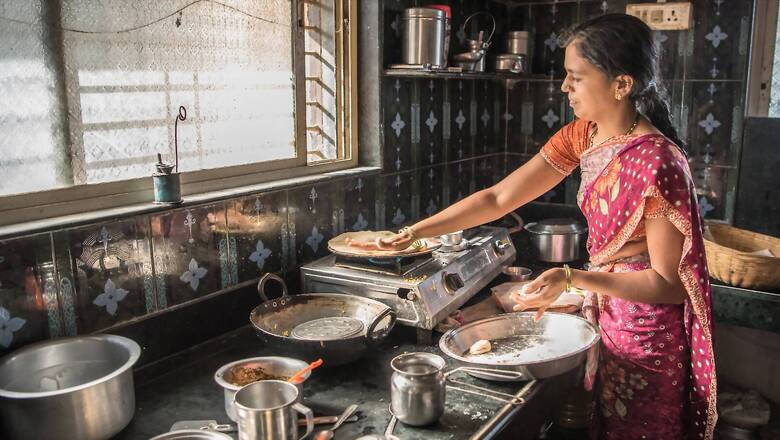
views
Gender, economic status, decision-making authority and dietary diversity all coexist in dynamic relationships. Malnutrition among women is increasing the disease burden in the nation. In India, a significant portion of women still have health problems, including anaemia, as a result of dietary deficits. Women continue to have monotonous diets with little to no inclusion of fruits and vegetables.
The parity of dietary intake has worsened since the onset of the pandemic, pushing more and more women towards undernourishment. With a focus on “Mahila aur Swasthya”, India is currently celebrating its 5th Annual Poshan Maah. Planning steps to enhance dietary diversity amongst women can help in improving nutritional outcomes amongst women.
Despite the fact that undernutrition is a major reason for worry in India, there are very few studies that examine the causes of poor diet diversity among vulnerable populations, such as pregnant women from rural areas. Still largely unexplored in the nation is the influence of socioeconomic factors on food diversity and subsequent maternal health problems. According to a 2020 study conducted in four areas across the nation, women often consume 0.1 to 0.5 less food categories than other family members. These variations are mainly concentrated in dietary groups that are more nourishing (like pulses, green-leafy vegetables, fruits, and dairy).
In India, the intra-household dynamics are complex and therefore it is important to understand them before planning interventions. Absence of dietary diversity in Indian women is caused by both internal and external factors. These factors may include, sex of head of the family, overall family income, educational status of women, external access to different types of crops, affordability of fruits and vegetables and several others. Indian women much like in several other developing countries, eat last and the least. The patriarchal system that most Indian households adhere to contributes to the nutritional difference as well. Boys and men are meant to be given the healthiest and most nourishment. The patriarchal system’s hold is further tightened by caste and class hierarchies, making it impossible for women to escape oppression. In other words, even though some nutritious meals may be available in households, many women do not eat them. Their meals are usually cereal centric, mostly involving just rice and wheat.
Larger Goal of Diet Diversification Amongst Women
The implications of nutrition interventions on child-birth outcome, wasting and stunting rates are indisputable today. Diet diversification amongst women can solve the issue of “Hidden Hunger” or micronutrient deficiency for all. When women consume healthy diets, it not only is better for their individual well-being but can also have implications for intergenerational health as well.
Healthy birth weights are more common among babies born to well-nourished mothers, and these babies are less likely to experience malnutrition in the future. Additionally, children of undernourished mothers are more likely to experience cognitive deficits, short stature, decreased infection resistance, as well as an increased risk of illness and mortality throughout their lives. General nutrition should begin in early childhood, not only when a woman is pregnant. However, improving dietary patterns amongst women should not only be looked upon as an instrumental goal but also an intrinsic one.
Covid-19 and Further Hampering
The micronutrient malnutrition is said to have further worsened since the onset of the Covid-19 pandemic. With nationwide lockdown and loss of jobs for lakhs of people across the country, food security became a huge issue. Increased prices of pulses, fruits and vegetables were beyond the purchasing power of many. Households reduced their spending on foods like fruits, vegetables, meat and eggs. Due to disruption of local food markets, the only source of nutrition that remained was through regular provision of rice and wheat. Apart from this, several community-led programmes that used to act as food safety nets for several women were ultimately affected and limited the access of nutritional diet for all.
How to Improve Dietary Diversification in Women
It is not like that presently we do not have schemes and programmes which are meant to improve dietary diversification levels amongst the citizens. The Government of India already has programmes for diversifying the cropping system such as Crop Diversification Programme (CDP), National Horticulture Mission, National Food Security Mission — Pulses. However, the problem lies in the proper implementation of these. There is a need to improve the coverage of these programmes and increase the production of crops, fruits and vegetables rich in micronutrients.
Apart from this more and more households should be encouraged and helped to grow several vegetables through nutri-gardens. A nutri-garden is a small patch of land, usually in the backyard of homes, used for growing multi-vegetables using local seeds and without the application of chemical fertilisers or pesticides. The local food and nutrition security can check the adverse effects of food supply shocks and food price volatility and can address women’s nutritional needs.
One such initiative has been the “Mo Upakari Bagicha” project implemented by the Odisha Livelihoods Mission across more than 750 gram panchayats of the state. The target audience of the project were women and children. The project has been successful and is planned to be upscaled to over 300 blocks. Similar initiatives on a larger scale can help promote diversification of food for women.
According to the NSSO survey, spending on protein and micronutrient rich foods such as fruits and vegetables is significantly less when compared to other food items. There is a need for national support for promoting nutrient dense crops and subsequently making them accessible and affordable for a large section of the population.
India currently has low researched data on diversity of dietary levels amongst women. Ensuring dietary diversity and quality can be difficult but is highly essential to tackle the larger problem at hand.
Mahek Nankani is Assistant Programme Manager, The Takshashila Institution. The views expressed in this article are those of the authors and do not represent the stand of this publication.
Read all the Latest Opinion News and Breaking News here

















Comments
0 comment